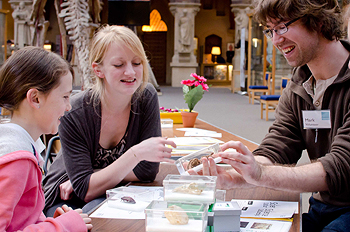Who the devil are this 'public' everyone keeps rambling on about?
The last two posts in this series, based on a recent paper by Ted Nield and Iain Stewart, addressed the issues of why should scientists bother communicating, and what do people in general already know about science, and geoscience in particular. Oddly, these are the most fundamental questions when it comes to science communication, but often can be the most difficult to answer. They either require a degree of personal subjectivity, or data that can be extremely difficult to obtain and measure in any meaningful way.
Throughout any discussion of science communication, the ‘engagees’ are typically referred to as ‘the general public’, and on a more specific level, public stakeholders – those who require or will use in some way the information being conveyed to them. Scientists are probably best at communicating between other branches of scientist, be they in academia, industry, government, or elsewhere. I guess this is due to the inherent fact that there will more often be a commonality of both understanding and interest, within fields, that may not be as highly replicated outside of these spheres.
But what about non-scientists in business and government? There can’t always be a geoscientist in these where one may be only briefly required. So how do you communicate with these sectors, where the challenge will often be to communicate potentially complex issues, as Stewart and Nield say, within the ‘vexing’ (great word) framework of institutional structures, decision-making, and often completely overwhelming and equally-complicated jargon of ‘policy speak’. Often, I don’t think this is as bad as is made out to be, but certainly sometimes it seems that actual substance and content can get lost among inane ramblings and meaningless buzzwords. Increasing the interaction between these spheres for greater mutual understanding is very much an on-going issue. Similar issues are encountered when transcending from science to planning documents, the “associated lexicon of the regulatory framework”, the educational system, and well, actually, thinking about it, anything that isn’t formally classified as ‘science’. Which actually raises the point that perhaps it’s science which needs to change the way in which it internally communicates, before scientists can be readily equipped to begin interacting with the various public domains.

With so many different levels of complexity to potentially communicate to and through, is it therefore any surprise why some scientists avoid public communication like the plague, or defer it to the media and journalists? What about these less-specific domains of the public. Go beyond jobs and background, and instead you find that there are equally disparate groups based on their actual interest in science. One commonly used sub-division, albeit a crudely defined one, is that of the ‘attentive public’, the ‘interested public’, and the ‘residual public’; the latter of these is an utterly thankless name, given the negative connotations associated with ‘residual’, as almost left overs.

The first of these sub-categories comprises 10-20% of the whole. Stewart and Nield highlight several social traits associated with people within this, including university-training, generally being younger, those who are interested in the news, read popular science or general science articles and magazines, attend museums and seek out information in general. Seeing as you’re currently reading a science blog (or at least what masquerades as one), that probably includes you. I do think this is a little unfair, as you don’t really have to be interested in science to do all of these things, and you could be interested in science but not actually do all or any of these. I think what it bores down to is awareness, or at least a desire to be aware of how the world around you works. But you can quite comfortably do this sitting in a park and using your brain.
The majority form the ‘interested public, some 40-50%. These are usually older, more distant from science (if you haven’t done a science degree, then chances are you won’t have had any scientific training since 18 or younger), watch scientific documentaries, and maintain an interest in science stories in the news. However, they will generally be largely uninformed (not ignorant, as many would put it, infuriatingly) about particular topics they maintain an interest in.
The ‘residual public’, or non-attentive, or crudely put, “scientifically illiterate” (something that I would never ever say to anyone, or even think about calling someone – not sure why Stewart and Nield put that in here) public who neither acknowledge nor have an interest in science, for any number of reasons.
What is significant, is that each of these broad, and not necessarily independent publics (probably better to think about the ‘general public’ as continuous data, with sliding scales defining these sub-categories depending on which parameters of ‘scientific-attentiveness’ you apply) requires a different mode of engagement. I think one difficulty with this is that you’ll never know who you’re really targeting. At a science museum, there is no guarantee that you’ll be communicating solely to members of the ‘attentive public’, so a degree of diversity and flexibility should be maintained. I guess the same thing applies to blogging, especially as every hit on here will be from an invisible member of the internet. So while focus can engage with a specific audience, you never know that it’s them you’ll be reaching, and flexibility and diversity can help maintain interaction with multiple audiences.
Nield and Stewart describe an initially disheartening issue, but then a comforting solution to approaching it. According to a previous study, the majority group, the ‘interested public’ are unlikely to pass a relatively minimal test of scientific literacy. This makes the information needs of this group particularly complicated, but suggestions that communication with this group should be non-technical and pictorial, generally speaking. They also conclude, worryingly, that there is no current consensus about how to interact with the ‘non-attentive public’. Seeing as they currently comprise, according to the above stats, anything from 30-50% of the general public, I’d propose that trying to figure out methods of interacting with this putative subset be made a priority for social scientists (and maybe a natural scientist or two), if not already.

So if we take this, and try and reconcile it with the notion of public stakeholder groups, it becomes a strategic nightmare. People don’t walk around with these labels attached to their heads. In the policy domain, it is traditionally accepted (but not necessarily practiced) that scientific expertise should be more strongly accepted over public opinion, although not at the compromise of democracy. It is actually sometimes the case that the two are still raucously opposed, such that policy can become a public relations battle, instead of an evidence-informed process. Take the case of fracking for example, both in the UK and USA.
When professional scientific advice clash with various rhetorics and public perceptions based on popular science culture or misinformation, or less rigorous information, it can be difficult to establish a method of communicating a particular message to a particular target – everything gets caught up in the spider’s web. The focus and context changes. Instead of trying to convey a message about a specific aspect of science, it becomes about engaging with this public baseline, albeit a potentially messy one, based on prior knowledge, social norms, beliefs, ethical standards, motivation, and interest in actually listening. Scientific knowledge is cultural, in this sense, and requires an approach that accepts, reflects, and understands that.
I’ll finish with what I think is the most important message from Stewart and Nield (who, now that I’ve met both of btw, can confirm are both totally awesome dudes).
“Public understanding of science becomes a long game in which we engage the public in a discussion about what interests them. That discussion is a dialogue, not a monologue. It is less about providing information and about providing context …. One way to frame [geological] information in more familiar ways is consider not what the public needs to know about geology, but what the public wants to know.”
While I think there are some things the public need to know about geology (how natural hazards work, how it records climate change and the record of the history of the planet – nothing big), the big message is about having a discussion with people. This is easy in the times of the internet, and even easier in person still. Test, learn, adapt – I think that’s how randomly controlled trials operate, but the same principles apply when it comes to direct or indirect science communication. Don’t talk at people, talk with them.
Next time, probably something about the news and media.
Communication of science is difficult, at best. When I taught (even now, most times when I talk about science), I could see the students’ eyes glaze over. I usually lost them in the first few minutes. It was, normally, up to myself and about three students to keep the discussion going. I loved teaching Science. It was, probably, my favorite subject. I love Science, period. So, frustration was high with me here, though I still tried my best every day. I understand.
SCott